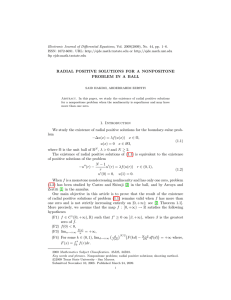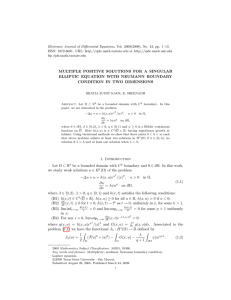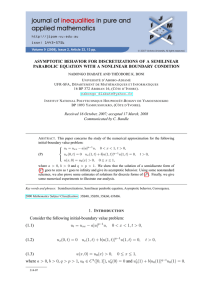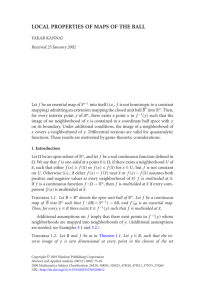Explicit constants for Riemannian inequalities Heather Macbeth November 6, 2012
advertisement
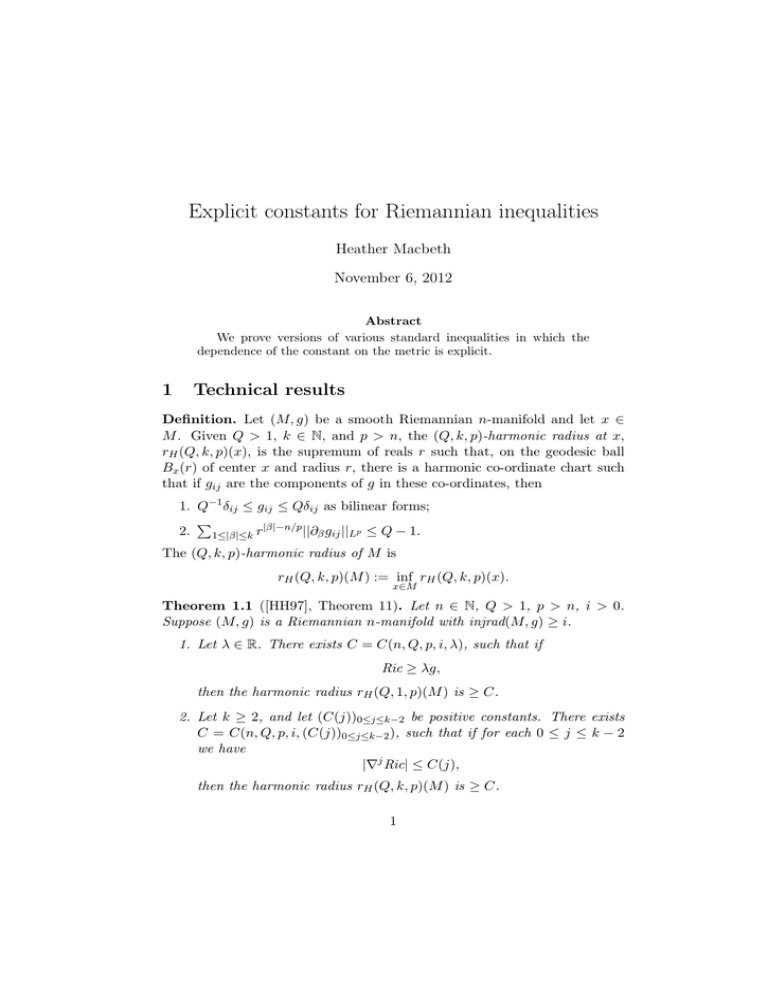
Explicit constants for Riemannian inequalities Heather Macbeth November 6, 2012 Abstract We prove versions of various standard inequalities in which the dependence of the constant on the metric is explicit. 1 Technical results Definition. Let (M, g) be a smooth Riemannian n-manifold and let x ∈ M . Given Q > 1, k ∈ N, and p > n, the (Q, k, p)-harmonic radius at x, rH (Q, k, p)(x), is the supremum of reals r such that, on the geodesic ball Bx (r) of center x and radius r, there is a harmonic co-ordinate chart such that if gij are the components of g in these co-ordinates, then 1. Q−1 δij ≤ gij ≤ Qδij as bilinear forms; P |β|−n/p ||∂ g || p ≤ Q − 1. 2. β ij L 1≤|β|≤k r The (Q, k, p)-harmonic radius of M is rH (Q, k, p)(M ) := inf rH (Q, k, p)(x). x∈M Theorem 1.1 ([HH97], Theorem 11). Let n ∈ N, Q > 1, p > n, i > 0. Suppose (M, g) is a Riemannian n-manifold with injrad(M, g) ≥ i. 1. Let λ ∈ R. There exists C = C(n, Q, p, i, λ), such that if Ric ≥ λg, then the harmonic radius rH (Q, 1, p)(M ) is ≥ C. 2. Let k ≥ 2, and let (C(j))0≤j≤k−2 be positive constants. There exists C = C(n, Q, p, i, (C(j))0≤j≤k−2 ), such that if for each 0 ≤ j ≤ k − 2 we have |∇j Ric| ≤ C(j), then the harmonic radius rH (Q, k, p)(M ) is ≥ C. 1 Lemma 1.2 ([Heb96], Lemma 1.6). Let n ∈ N, let λ ∈ R, and let r ≥ ρ > 0. Let (M, g) be a complete Riemannian n-manifold with Ric ≥ λg. Then there exist N = N (n, λ, ρ, r), and an (at most) countable set (xi ) of points in M , such that 1. the family (B(xi , ρ)) covers M ; 2. each point in M is contained in at most N (n, λ, ρ, r) balls of the family (B(xi , r)). Let U ⊆ Rn be an open set, g a Riemannian metric on u, ∇ its LeviCivita connection, and Γ the Christoffel symbols of g on the co-ordinate patch U . We write D for the (Euclidean) derivative on U . In the following we denote by S a multilinear map S : Tba11 (Rn ) × Tba22 (Rn ) × . . . × Tbarr (Rn ) → Tba (Rn ), P P composed of sums of traces (so a − b = ai − bi ). It is to be understood that the particular map S, and the ai ’s, bi ’s, a and b determining its domain and range, may vary from use to use and from line to line, but are independent of the choice of g, and of the choice of A (in (1)) or of u (in (2)). Lemma 1.3. 1. Let k ∈ N. For all covariant tensors A : U → T k (Rn ), ∇A = DA + S(Γ, A). 2. Let m ∈ N. For all functions u : U → R, m m (∇) u = D u + m−1 X m−k X k=1 Proof. r=1 X S(Da1 Γ, . . . Dar Γ, Dk u). a1 ≥···≥ar ≥0, a1 +···+ar =m−k−r 1. For any covariant tensor A, X (∇A)(∂j , ∂i1 , . . . ∂ik ) = ∂j (A(∂i1 , . . . ∂ik ))− Γajir A(∂i1 , . . . ∂a , . . . ∂ik ) r 2. For m = 0, 1 these are the identities u = u, 2 ∇u = du. Thenceforth we proceed by induction. Suppose this is known for some m. Then (∇) m+1 m u = ∇(D u)+ m−1 X m−k X k=1 r=1 X ∇ S(Da1 Γ, . . . Dar Γ, Dk u) , a1 ≥···≥ar ≥0, a1 +···+ar =m−k−r and we may calculate ∇(Dm u) = Dm+1 u + S(Γ, Dm u), r X ∇ S(Da1 Γ, . . . Dar Γ, Dk u) = S(Da1 Γ, . . . Dai +1 , . . . Dar Γ, Dk u) i=1 +S(Da1 Γ, . . . Dar Γ, Dk+1 u) +S(Da1 Γ, . . . Dar Γ, Γ, Dk u). The result follows. 2 Sobolev estimates Theorem 2.1 (Sobolev estimate, Gilbarg-Trudinger [GT01] 7.10 & 7.25). For each n, p 6= n, and bounded domain V with C 1 boundary, there exists C = C(n, p, V ), such that for all functions u ∈ W 1,p (V ), we have 1. if p < n, ||u|| np ,V n−p ≤ C||u||W 1,p ;V . 2. if p > n, sup |u| ≤ C||u||W 1,p ;V V Lemma 2.2 (Local Sobolev estimate). Let n, m, i, λ be given. 1. Let q < p < n be given. Then there exists r = r(n, p, q, m, i, λ) < i and C = C(n, p, q, m, i, λ), 2. Let p > n be given. Then there exists r = r(n, p, m, i, λ) < i and C = C(n, p, m, i, λ), such that for each • complete Riemannian n-manifold (M, g) with injectivity radius at least i and Ric ≥ λg 3 • point x ∈ M • smooth covariant m-tensor A on B(x, r), we have 1. (if p < n) ||A||pnq n−q ,g,B(x,r) h i ≤ C ||∇A||pp,g,B(x,r) + ||A||pp,g,B(x,r) . 2. (if p > n) !p sup |A|g B(x,r) h i ≤ C ||∇A||pp,g,B(x,r) + ||A||pp,g,B(x,r) . Proof. If p > n, let q := 12 (n + p). Then, either way, let s= pq , p−q and choose r to be less than i and less than the C(n, Q := 1, s, i, λ) of Theorem 1.1 (1), so that the harmonic radius rH (Q := 1, 1, s) is greater than r. We therefore have uniform bounds in terms of n, i, λ, p, and (if p < n) q on the co-ordinate norms ||g||s,B(x,r) , ||g −1 ||s,B(x,r) , ||Γ||s,B(x,r) . Write B for B(x, r) throughout. Let u be a function on B, with u ∈ m+1,p (B) ∩ Lp (B). Wloc By our bounds on the components of the tensor g, the metrics g and geucl are comparable, so the norms || · ||p,g,B and || · ||p,B are comparable, the norms || · || nq p,g,B and || · || nq ,B are comparable, and the pointwise n−q n−q tensor norms | · |g and | · | are comparable. It therefore it suffices to prove the inequalities with the latter norms. Applying the Sobolev inequality Theorem 2.1 co-ordinatewise and combining, we have C = C(n, m, q), such that 1. (if p < n) ||A||qnq n−q 2. (if p > n) ,B h i ≤ C ||DA||qq,B + ||A||qq,B . q h i q q sup |A| ≤ C ||DA||q,B + ||A||q,B . B 4 By Lemma 1.3 (1) and the power means inequalities, h ||DA||qq,B + ||A||qq,B ip q p −1 p −1 ≤ 2q h ||DA||pq,B + ||A||pq,B i i (||∇A||q,B + ||S(Γ, A)||q,B )p + ||A||pq,B h i p −1 ≤ 2q 2p−1 ||∇A||pq,B + ||S(Γ, A)||pq,B + ||A||pq,B . ≤ 2q h By Hölder’s inequality, for C = C(n, m), ||∇A||q,B ≤ C||1||s,B ||∇A||p,B ||S(Γ, A)||q,B ≤ C||Γ||s,B ||A||p,B ||A||q,B ≤ C||1||s,B ||A||p,B The terms other than A, ∇A in these right-hand sides are controlled by construction. The result follows. Proposition 2.3 (Sobolev inequalities). Let n, m, i, λ be given. 1. Let q < p < n be given. Then there exists C = C(n, p, q, m, i, λ), 2. Let p > n be given. Then there exists C = C(n, p, m, i, λ), such that for each • complete Riemannian n-manifold (M, g) with injectivity radius at least i and Ric ≥ λg • smooth function u on M , we have 1. (if p < n) ||u|| W nq m, n−q ,g ≤ C||u||W m+1,p ,g . 2. (if p > n) ||u||C m ,g ≤ C||u||W m+1,p ,g . Proof. Choose r and C from the local Sobolev estimate Lemma 2.2. By Lemma 1.2, there exist N = N (n, A, r, r) and an (at most) countable set (xα ) of points in M , such that each point in M is contained in at least one and at most N balls of the family (B(xα , r)). Let χα be the characteristic function of B(xα , r). 5 By Minkowski’s inequality (that is, the triangle inequality), we have, X ||A||pnq ≤ || χα |A|p || nq p(n−q) n−q α ≤ X = X ||χα |A|p || nq p(n−q) α ||A||pnq n−q α ,Bα By the local Sobolev inequality Lemma 2.2, Z Z p p ||A|| nq ,Bα ≤ C |∇A| + n−q Bα p |A| Bα So, since each point is in at most N of the Bα ’s, Z X Z p p |∇A| + ||A|| nq ≤ C n−q Z Z p ≤ NC |A| p Bα Bα α |∇A| + M p |A| . M Similarly, if p > n, by the local Sobolev inequality Lemma 2.2, p p sup |A|g = max sup |A|g α M Bα Z Z p p |A| |∇A| + ≤ C max α Bα Bα Z Z ≤ C |∇A|p + |A|p . M M Now, applying these inequalities simultaneously to the covariant tensors A = ∇i u, for each 0 ≤ i ≤ m, and summing, we obtain, as required, 1. (if p < n) m X i=0 ||∇i u|| nq n−q nq ,g n−q ≤ C m X ! ||∇i u||pnq i=0 ≤ C m+1 X i=0 6 n−q nq p(n−q) ,g nq ! p(n−q) ||∇i u||pp,g . 2. (if p > n) m X sup |∇i u|g ≤ C i=0 M p m X i sup |∇ u|g ≤ C p M i=0 m+1 X !1 !1/p i ||∇ u||pp,g . i=0 3 Elliptic estimates Theorem 3.1 (Lp estimates, Gilbarg-Trudinger [GT01] 9.11, modified). For each n, p, m, U , V ⊂⊂ U , λ, Λ, µ : R+ → R+ increasing, there exists C = C(n, p, U, V, λ, Λ, µ), such that if Lu := aij ∂i ∂j u + bi ∂i u satisfies • For all x ∈ U and ξ ∈ Rn , aij (x)ξi ξj ≥ λ|ξ|2 ; • ||aij ||m,∞ , ||bi ||m,∞ ≤ Λ; • For all x, y ∈ U , aij (x) − aij (y) ≤ µ(|x − y|) m+2,p then for all functions u ∈ Wloc (U ) ∩ Lp (U ), ||u||m+2,p;V ≤ C(||Lu||m,p;U + ||u||p;U ). Lemma 3.2 (Local elliptic estimate). Let n, p, m, i, A be given. Then there exists r = r(n, p, m, i, A) < i and C = C(n, p, m, i, A), such that for each • complete Riemannian n-manifold (M, g) with injectivity radius at least i and ||Ric||C m ,g ≤ A, • point x ∈ M , • smooth function u on B(x, r), 7 we have m+2 X " ||(∇)i u||pp;g,B(x,r/2) ≤C i=0 m X ! ||(∇)i ∆g u||pp;g,B(x,r) # + ||u||pp;g,B(x,r) i=0 Proof. Let q > n be arbitrary. Choose r to be < i and less than or equal to the C(n, Q := 1, q, i, (A)0≤i≤m ) of Theorem 1.1 (2), so that the harmonic radius rH (Q := 1, m + 2, q) is at least r. By the Sobolev estimate Theorem 2.1 (2), we therefore have uniform bounds in terms of n, m, i, A on ||g||∞,B(x,r) , ||g −1 ||∞,B(x,r) , ||D(g −1 )||∞,B(x,r) , ||Γ||m,∞,B(x,r) . For shorthand we write B1 for B(x, r/2) and B2 for B(x, r). Let u be a m+2,p function on B2 , with u ∈ Wloc (B2 ) ∩ Lp (B2 ). Since (by our bounds on the components of the tensor g) the metrics g and geucl are comparable, the norms || · ||p,g,B1 and || · ||p,B1 are comparable and the norms || · ||p,g,B2 and || · ||p,B2 are comparable. It therefore suffices to prove the inequality with the latter norms. By Lemma 1.3 (2), ! m+2 m+2 m X X X ||(∇)i u||pp;B1 ≤ C ||Di Γ||∞;B1 ||Di u||pp;B1 i=0 m X ||D i=0 i=0 i ∆g u||pp;B2 ≤C m−2 X i=0 ! i ||D Γ||∞;B2 i=0 m X ||(∇)i ∆g u||pp;B2 i=0 (where if m − 2 < 0 the second inequality is simply an identity). Also, applying the Lp estimate of Theorem 3.1 with the operator Lu = ∆g u = g ij ∂i ∂j u + g ij Γkij ∂k u shows: there exists C = C(n, p, m, r, ||g||m,∞,B2 , ||g −1 ||m,∞,B2 , ||Γ||m,∞,B2 ) such that p !1 m+2 m p X X ||Di u||pp;B1 ≤ C ||Di ∆g u||pp;B2 + ||u||p,B2 i=0 i=0 ≤ 2p−1 C m X ! ||Di ∆g u||pp;B2 + i=0 Combining these three inequalities gives the result. 8 ||u||pp,B2 . Proposition 3.3 (Lp estimate). Let n, p, m, i, A be given. Then there exists C = C(n, p, m, i, A), such that if (M, g) is a complete Riemannian n-manifold with injectivity radius at least i, ||Ric||C m ,g ≤ A, and u a smooth function on M , then ||u||W m+2,p ,g ≤ C[||∆g u||W m,p ,g + ||u||p,g ]. Proof. Choose r and C (dependent on n, p, m, i, A) as in the local elliptic estimate Lemma 3.2. By Lemma 1.2 (setting ρ = 21 r), there exists N = N (n, A, 12 r, r) and an (at most) countable set (xα ) of points in M , such that 1. the family (B(xα , 21 r)) covers M ; 2. each point in M is contained in at most N balls of the family (B(xi , r)). So, by the local elliptic estimate Lemma 3.2, ||u||pW m+2,p ,g ≤ m+2 XX i=0 α " ≤ C ||(∇)i u||pp;g,B(xα ,r/2) X m X ! ||(∇)i ∆g u||pp;g,B(xα ,r) # + ||u||pp;g,B(xα ,r) α ≤ i=0 N C[||∆g u||pW m,p ,g + ||u||pp,g ] ≤ 2N C[||∆g u||W m,p ,g + ||u||p,g ]p . 4 Moser’s Harnack inequality Theorem 4.1 (Harnack inequality, Gilbarg-Trudinger [GT01] 8.21). For each n, r, λ, Λ, there exists C = C(n, r, λ, Λ), such that if the operator L on W 1,2 (B4r )), Lu := ∂i (aij ∂j u) + cu, satisfies • For all x ∈ U and ξ ∈ Rn , aij (x)ξi ξj ≥ λ|ξ|2 ; • ||aij ||∞ , ||c||∞ ≤ Λ; 9 then for all functions u ∈ W 1,2 (B4r ) with u ≥ 0 and Lu = 0, sup u ≤ C inf u. Br Br Proposition 4.2 (Harnack inequality). Let n, i, λ, B, D be given. Then there exists C = C(n, i, λ, B, D), such that for each • compact Riemannian n-manifold (M, g) with injectivity radius at least i, Ricci curvature Ric ≥ λg, and diameter at most D, • smooth function u on M with u ≥ 0 and |∆g u| ≤ B|u| we have sup u ≤ C inf u. M M Proof. Let p > n be arbitrary; choose 4r to be < i and less than or equal to the C(n, Q := 1, p, i, λ) of Theorem 1.1 (1), so that the harmonic radius rH (Q := 1, 1, p) is at least 4r. By the Sobolev estimate Theorem 2.1 (2), we therefore have uniform bounds in terms of n, i, λ on, for each x ∈ M , the co-ordinate norms ||g||∞,B(x,4r) , ||g −1 ||∞,B(x,4r) . Define a measurable function c on M by, 0, if u(x) = 0 √ c(x) = − |g|(∆g u)(x) , if u(x) 6= 0. u(x) √ n/2 This function satisfies the bound ||c||∞ ≤ n!||g||∞,B(x,4r) B < ∞. By p construction |g|∆g u + cu = 0. Applying the Harnack estimate of Theorem 4.1 with the operator p p Lu = ( |g|∆g + c)u = ∂i ( |g|g ij ∂j u) + cu, we deduce that for C = C(n, i, λ, B), for each x ∈ M , sup u ≤ C inf u. B(x,r) B(x,r) Applying Lemma 1.2 with (ρ, r) = (r, D), we obtain an integer N = N (n, λ, r, D) such that M may be covered by a set of at most N radius-r balls. Let (Bα )α∈A be such a covering. 10 For any two balls Bα , Bβ in the set, there exists a sequence α0 := α, α1 , . . . αl := β, with l ≤ |A|−1, such that each pair Bαi , Bαi+1 of adjacent balls in the sequence intersects. Thus, for each 0 ≤ i ≤ l − 1, inf u ≤ B αi inf Bαi ∩Bαi+1 u ≤ sup u. Bαi+1 Therefore, by induction, sup u ≤ C N inf u. Bβ Bα Since this holds for all α, β ∈ A, and (Bα )α∈A cover M , we conclude sup u ≤ C N inf u. M M References [GT01] David Gilbarg and Neil S. Trudinger. Elliptic partial differential equations of second order. Classics in Mathematics. Springer-Verlag, Berlin, 2001. Reprint of the 1998 edition. [Heb96] Emmanuel Hebey. Sobolev spaces on Riemannian manifolds, volume 1635 of Lecture Notes in Mathematics. Springer-Verlag, Berlin, 1996. [HH97] E. Hebey and M. Herzlich. Harmonic coordinates, harmonic radius and convergence of Riemannian manifolds. Rend. Mat. Appl. (7), 17(4):569– 605 (1998), 1997. 11
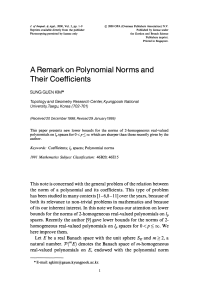



![5.5 The Haar basis is Unconditional in L [0, 1], 1 < 1](http://s2.studylib.net/store/data/010396305_1-450d5558097f626a0645448301e2bb4e-300x300.png)

